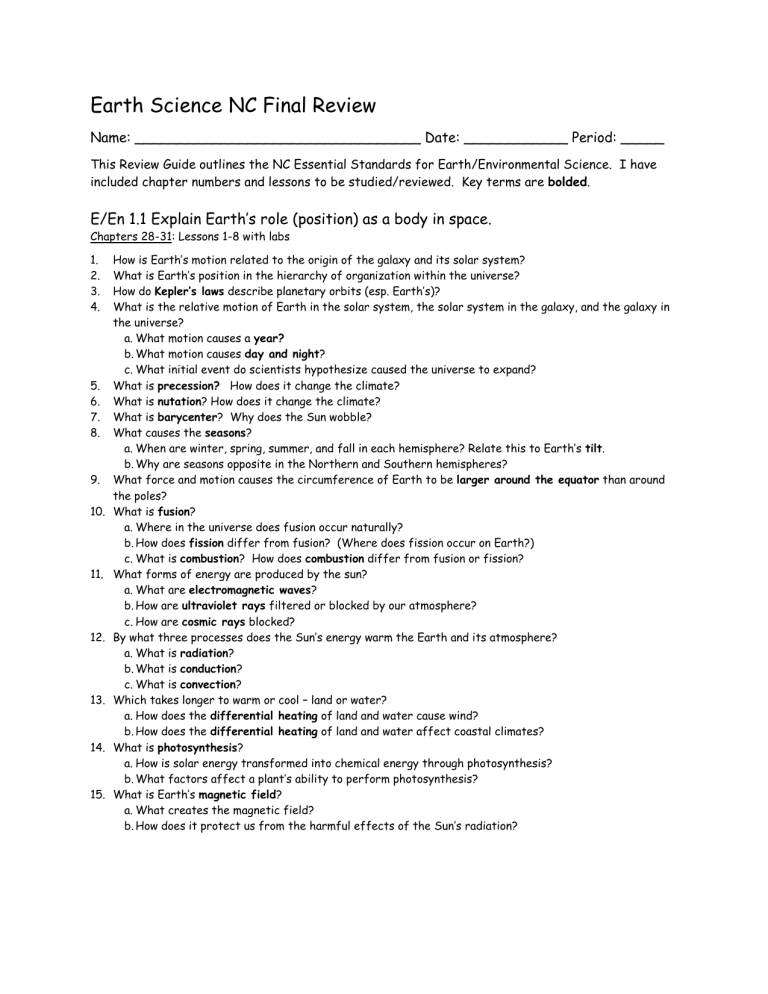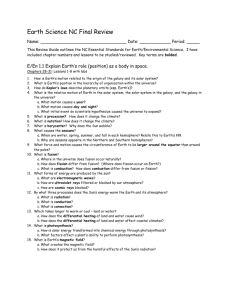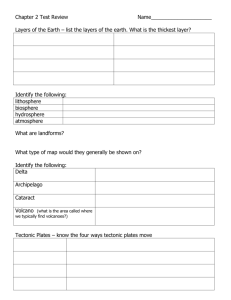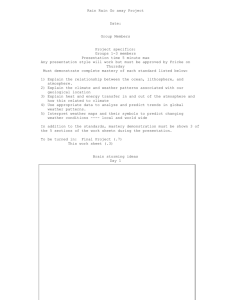
Earth Science NC Final Review Name: _________________________________ Date: ____________ Period: _____ This Review Guide outlines the NC Essential Standards for Earth/Environmental Science. I have included chapter numbers and lessons to be studied/reviewed. Key terms are bolded. E/En 1.1 Explain Earth’s role (position) as a body in space. Chapters 28-31: Lessons 1-8 with labs 1. 2. 3. 4. 5. 6. 7. 8. 9. 10. 11. 12. 13. 14. 15. How is Earth’s motion related to the origin of the galaxy and its solar system? What is Earth’s position in the hierarchy of organization within the universe? How do Kepler’s laws describe planetary orbits (esp. Earth’s)? What is the relative motion of Earth in the solar system, the solar system in the galaxy, and the galaxy in the universe? a. What motion causes a year? b. What motion causes day and night? c. What initial event do scientists hypothesize caused the universe to expand? What is precession? How does it change the climate? What is nutation? How does it change the climate? What is barycenter? Why does the Sun wobble? What causes the seasons? a. When are winter, spring, summer, and fall in each hemisphere? Relate this to Earth’s tilt. b. Why are seasons opposite in the Northern and Southern hemispheres? What force and motion causes the circumference of Earth to be larger around the equator than around the poles? What is fusion? a. Where in the universe does fusion occur naturally? b. How does fission differ from fusion? (Where does fission occur on Earth?) c. What is combustion? How does combustion differ from fusion or fission? What forms of energy are produced by the sun? a. What are electromagnetic waves? b. How are ultraviolet rays filtered or blocked by our atmosphere? c. How are cosmic rays blocked? By what three processes does the Sun’s energy warm the Earth and its atmosphere? a. What is radiation? b. What is conduction? c. What is convection? Which takes longer to warm or cool – land or water? a. How does the differential heating of land and water cause wind? b. How does the differential heating of land and water affect coastal climates? What is photosynthesis? a. How is solar energy transformed into chemical energy through photosynthesis? b. What factors affect a plant’s ability to perform photosynthesis? What is Earth’s magnetic field? a. What creates the magnetic field? b. How does it protect us from the harmful effects of the Sun’s radiation? E/En 2.1: Explain how processes and forces affect the lithosphere. E/En 2.2.1: Understand how human influences impact the lithosphere. Chapters 4-6: Lessons 1-5; 1. What are the processes that change one type of rock into another type in the rock cycle? a. What processes form igneous rocks? b. What processes form sedimentary rocks? c. What processes form metamorphic rocks? Chapters 7-8: Lessons 1-7 with labs; 2. What is weathering? How is it related to the rock cycle? a. What is the difference between chemical weathering and physical weathering? b. What are ways that rocks can be chemically weathered? Physically weathered? c. In which type of climate do rocks experience more chemical weathering? Physical weathering? d. Which types of rocks are more easily physically weathered? e. What type of weathering produces caves and clay? f. How does weathering help to make soil? 3. What is soil? a. How do the three particle types of soil (clay, silt, sand) differ? b. How can a soil texture triangle be used to determine the texture of soil in a location? c. What type of soil is found in the desert, the tundra, the tropical forest, and the temperate (deciduous) forest and grasslands? 4. What is the difference between renewable and nonrenewable resources? 5. What consequences do the following environmental issues have on the lithosphere – desertification, monoculture, pesticide use, erosion, deforestation, urbanization? What is each? How can the effects of each situation be prevented or lessened? Why do we use traditional agriculture? 6. What is erosion? a. How does water cause erosion? What is a delta? What is an alluvial fan? b. How does wind cause erosion? What is abrasion? What is deflation? What is desert pavement? What is a sand dune? c. How do glaciers cause erosion? What is a moraine? What is till? d. What are the types of mass movements of Earth materials due to the force of gravity? How do the following types of mass movements change Earth’s surface – landslides, slumps, avalanche, rock slide (fall), creep? e. Which locations would be most at risk for the destruction of buildings due to mass movements? How might this destruction be prevented? f. What is the effect of human activity on shorelines? What are artificial stabilization efforts used to prevent shore erosion? (What is a jetty, groin, seawall, breakwater?) g. What is the effect of human activity on mountainsides? What are artificial stabilization efforts used to prevent erosion on mountainsides? Chapters 17-19: Lessons 1-10 with labs 7. (Ch 17) What is the theory of plate tectonics? What tectonic features do scientists look at on a world map that indicates that Earth’s lithosphere is broken into giant plates? 8. How are the plates moving at each of the following plate boundaries - divergent, convergent, transform? a. What might the convection currents in the mantle under each of these boundaries look like? (That is, in which direction are they flowing?) b. How do the forces of ridge push and slab pull move the tectonic plates? 9. What geologic events/landforms occur at of the following plate boundaries – divergent, convergent (ocean/ocean), convergent (ocean/continental), convergent (continental/ continental), transform? Answer the following questions. Studying diagrams would be immensely helpful!! a. At which boundary is seafloor spreading occurring? b. Which of the boundaries form fissure volcanoes, a rift valley, or a midocean ridge? c. Which of the boundaries form volcanic islands? 10. 11. 12. 13. 14. 15. 16. 17. 18. d. Which of the boundaries form a volcanic mountain range near a coastline? e. At which boundary is an ocean trench present? f. What forms an ocean trench? g. What is a subduction zone? What often forms above a subduction zone? h. Where is the ring of fire? i. At which boundary are folded mountains (such as the Appalachians) formed? How did the Appalachian Mountains of N. Carolina form? (See Computer Lab and p. 532-534..) a. What type of boundary created the Appalachian Mtns? b. When did these events occur? c. What is a fall zone? d. How were our barrier islands formed? (Ch 18) What is a volcano? a. What is the difference between magma and lava? b. How does a shield cone (Hawaii) form? What effects does that have on the lithosphere? c. How does a cinder cone (Central America) form? What effects does that have on the lithosphere? d. How does a composite volcano (Mt. St. Helens/ Vesuvius) form? What effects does that have on the lithosphere? e. What is a lahar? A lava flow? A pyroclastic flow? How does each affect the lithosphere? f. What is volcanic ash? How does it affect the atmosphere and global temperatures? g. Where do most volcanoes form? What is a hot spot volcano? (Ch 19) What causes an earthquake? a. What is stress? What do - compression, tension, shear - result in? b. What is a fault? c. What type of stress and rock movement are found at each of the 3 types of faults - reverse, normal, strike-slip? d. What are seismic waves? i. How do the following types of seismic waves - primary, secondary, surface - move the rocks through which they travel? Which are fastest? Which do the most damage? ii. What does a Travel-Time Graph show? (You should be able to use one!) iii. What is the focus of an EQ? What is the epicenter? How can an EQ’s epicenter be located? (Be able to locate the epicenter if given the arrival times of P-waves and S-waves.) How do the following scales - Richter, Modified Mercalli - measure the intensity of earthquakes? What numbers are used by each? What does each successive number represent? How is a seismic intensity map made? Which of our states have the highest seismic risk? What is North Carolina’s seismic risk? Is it the same across the state? Where on Earth do most EQs occur? (If plotting the locations of EQs on a world map, what pattern would you see?) How do the following EQ hazards - pancaking, soil liquefaction, fault scarp, tsunami – affect the lithosphere and human life and property? What precautions can be taken to prevent the loss of human life and destruction to property due to EQs? Where is each located - crust, upper mantle, asthenosphere, lower mantle, core? E/En 2.3: Explain the structure and processes within the hydrosphere. E/En 2.4: Evaluate how humans use water. Chapters 9-10: Lessons 1-8; Additional material from Chapters 15-16 as needed. 1. 2. (Ch 15) When sea ice melts, the water gets cold and salty and sinks - why? a. Where does cold water from the poles go? b. What does deep ocean water do as it reaches the equator and warms? c. What is an upwelling? What causes it? (Ch 9) How do each of these processes of the water cycle work? evaporation, transpiration, condensation, precipitation, and infiltration. 3. 4. 5. 6. 7. 8. 9. 10. 11. 12. 13. 14. 15. 16. 17. 18. What is the connection between surface water and groundwater? How does each turn into the other? What are the following parts of a river? – river, tributaries, watershed, divide, floodplain, meander, headwaters, and mouth? Where does water in a river flow the fastest? the slowest? Which part of a meander would be eroded more – the inside or outside? (Hint, where is water moving fastest?) What causes floods? How do groundwater levels affect flooding? List threats to the Yadkin-PeeDee River. What is eutrophication? What can speed it up? Where would the following types of wetlands be found in N. Carolina – bogs, swamps, marshes? a. What are two important functions of wetlands? b. What human activities can degrade (harm) our wetlands? c. What are three ways our wetlands can be preserved? d. What is an estuary? Where does the fresh and salt water come from? How would an upstream drought affect the water in an estuary? Where is most of Earth’s water? Where is most of Earth’s fresh water? How are the following terms describing groundwater defined – porosity, aquifer, aquiclude, zone of saturation, water table? What is a well? The following are consequences of the overuse of groundwater… a. What is drawdown? b. What is aquifer depletion? c. What is subsistence? d. What causes salt-water intrusion into wells in coastal areas? What are some threats to our groundwater supplies? a. What substance is drawn up when wells are over pumped? b. Can most chemical contaminants be easily removed from groundwater? c. How can our groundwater be protected and restored? What are 4 important uses of freshwater in our country? a. How water use differ in different parts of our country? b. How is water used in NC? c. What are dams built for? What is the difference between point and nonpoint pollution? What are examples of each? Include sedimentation and stormwater runoff in your answer. a. What are sources of arsenic in groundwater? b. What is the difference between groundwater and surface water pollution? Which is easier to pollute? To clean up? c. What chemical & physical factors affect the quality of NC streams? d. How is the biotic index used to determine the quality of water in a stream? e. Where is a stream most affected by pollution – headwaters or mouth – and why? How is water treated to make it potable (drinkable)? a. What is the effect of population growth on potable water sources? b. What two laws were passed to ensure clean, drinkable water? How can farmers, industries, every day people conserve water? E/En 2.5: Understand the structure of and processes within our atmosphere. Chapters 11-13: Lessons 1-10 1. 2. (Ch 11) What is the most abundant gas in the atmosphere? By what percent? The second most? By what percent? What are the functions/importances of the following substances in the atmosphere… oxygen, carbon dioxide, ozone, water vapor, water, ice, dust and salt 3. 4. 5. 6. 7. 8. 9. 10. 11. 12. 13. 14. 15. 16. 17. 18. 19. 20. 21. 22. 23. 24. What are the characteristics and composition of the 5 layers of the atmosphere – troposphere, stratosphere, mesosphere, thermosphere, exosphere? What is found in each? a. Where is the ozone layer? Why is it so important to life on Earth? b. How does the temperature, pressure, & density vary as one moves up the troposphere? c. What characteristic is used to identify the layers of the atmosphere? d. Why is the thermosphere said to be the hottest layer when it feels so cold up there? How much of the sun’s energy does Earth’s surface absorb? What happens to the rest of it? What is dew point? What does it tell us? If warm air and cold air collide, which will rise? a. Why does warm air rise? b. Why does cold air sink? What creates wind? What is relative humidity? a. What instrument is used to determine relative humidity? b. How is a relative humidity chart used? How are clouds formed? What part of the water cycle is involved? a. What is the lifted condensation level? b. What is orographic lifting? (Ch 12) What is the difference between weather and climate? What are the location and characteristics of the 5 major air masses that affect the weather of the USA? continental tropical, maritime tropical, continental polar, continental tropical, Arctic What is the location (by latitude) and wind direction of the each of the global wind systems… polar easterlies, prevailing westerlies, trade winds. Which is responsible for the movement of weather across the USA? What is a jet stream? What are the horse latitudes and the doldrums? What causes them? What causes the four types of fronts - cold, warm, stationary, occluded? Identify symbols for each & describe the weather & clouds each causes. What happens to temperature of an area after each passes? Be able to read a weather map! (Geolab 6) What are isobars? Isotherms? What type of wind is represented by isobars that are close together? (strong or weak?) Describe the 2 types of pressure systems – high and low. Recognize the symbol for each. What kind of weather do they cause? What kind of data is collected by the following weather instruments – thermometer, barometer, anemometer, hygrometer (psychrometer), ceilometers What type of data do radiosondes collect – in general and specifically? What is radar? a. What is radar used to track? b. What is Doppler radar used for? How is a station model read? Why are station models used? (Ch 13) Where do the majority of thunderstorms occur in the USA? a. When and where do the following types of thunderstorms occur – sea breeze, orographic? b. Where is the safest place to be during a thunderstorm? What is a tornado? a. Review the Enhanced Fujita Scale. What does it measure? When and how does it measure that? b. Where is Tornado Alley? c. Which 2 air masses create tornados? During which month do most tornadoes occur? d. Where is the safest place to be in during a tornado? What is a tropical cyclone? (a hurricane?) a. Where do cyclones derive their energy? What causes them to lose strength? b. Which direction do hurricanes spin and which way do they usually move in the N. hemisphere? c. Which wind system pushes them back to the east? d. Do winds increase or decrease as a hurricane strengthens? What about air pressure? e. What does the Saffir-Simpson Scale classify? 25. Hurricane Hazards… a. Where are the strongest winds in a hurricane? b. What is a storm surge? What kills 9 out of 10 people who die in hurricanes? c. What is the number 1 safety tip for surviving a hurricane? 26. How does acid rain form? a. What human activities alter the pH of rain to cause acid rain? b. What can coal-burning power plants do to prevent acid rain? c. How does sea water acidification affect the oceans? 27. How do the following activities affect the quality of atmospheric composition? a. How do aerosols affect the atmosphere? b. How do chlorofluorocarbons affect the atmosphere? c. How does burning of wood or fossil fuels affect the atmosphere? d. How do industrial byproducts affect the atmosphere? e. How does over-farming affect the atmosphere? Look at each of the activities above. How can people reduce their negative impact on the atmosphere for each activity? E/En 2.6: Analyze patterns of global climate change over time. E/En 2.7: Explain how the lithosphere, hydrosphere, and atmosphere individually and collectively affect the biosphere over time. Chapter 14 Lessons 1-6 1. 2. 3. 4. 5. 6. 7. 8. 9. 10. 11. 12. 13. 14. 15. What are 3 factors that describe the climate of a location? Where is each of the following climate zones located - tropics, temperate, polar? a. In general, what temperatures would you experience in each zone? b. Why does it get colder as one moves toward the poles? What is the rain shadow effect? What does it create on the leeward side of a high mountain range? How do ocean currents affect climate? a. Which current affects our climate? California’s? b. On which coast would you find cold currents? Warm currents? How do coastal climates differ from continental (inland) climates? Why? What does the Koeppen classification system classify? Which climate zone, class, and subclass do WE live in? What is a microclimate? Give an example. Are coastal areas cooler or warmer than inland areas in the winter? (Think about the difference in temperature between Clemmons and Wilmington.) What is a heat island? Give an example. What is a biome? What do the terms biotic factors and abiotic factors mean? What are the characteristics of the six biomes… How can you describe the climate of each? What plants and animals live in each? What adaptations must the plants and animals have to survive in each biome? What air mass is each affected by? a. Tundra b. Taiga c. Deciduous forest d. Desert e. Grasslands f. Rain forest Which biome is most of North Carolina in? What is an ice age? How does an ice age affect sea level? What is El Niño? a. Which current is affected? How does pressure change in the Pacific Ocean? 16. 17. 18. 19. 20. 21. 22. 23. 24. b. Which global wind system weakens? c. Why is the cold upwelling along the Peruvian Coast so important? d. What happens to the fisheries when the water warms? e. How does it affect the California coast? The Gulf Coast? The Atlantic? How do the absence (or presence) of sunspots affect Earth’s climate? Why was the Maunder Minimum (Little Ice Age) so cold? How does a more elliptical orbit affect Earth’s climate? How do large volcanic eruptions affect Earth’s climate? How does extra carbon dioxide in the atmosphere affect Earth’s climate? (Answer this question with the standard statement about CO2 being a toxic, greenhouse gas that causes global warming - for your Exam!) a. How do changes in global temperatures affect agriculture? b. How do changes in global temperatures affect species diversity (esp. amphibians)? c. How do changes in global temperatures affect ecosystem balance? d. How do changes in global temperatures affect weather events? e. How do changes in global temperatures affect sea level? (esp. during warming) Related to this… i. How do glaciers affect sea level? ii. How does plate movement affect sea level? f. How are the shorelines and barrier islands of NC affected by sea level rise? g. How do changes in global temperatures affect ocean acidification? (and sea life) What is the biosphere? What is biodiversity? a. What is genetic biodiversity? Why is it important? What is a species that has lost genetic biodiversity? b. Which biome has the most biodiversity? Why? c. Which biome has the least biodiversity? Why? What are 5 things that can reduce biodiversity? a. Specifically, what is an invasive species? How does it impact biodiversity? What is an example of an invasive species here in NC? b. What is overharvesting? c. What is habitat alteration? What impact does the loss of biodiversity have on our society – local and global? How can we prevent the loss of biodiversity? E/En 2.8: Evaluate human behaviors in terms of how likely they are to ensure the ability to live sustainably on Earth. Chapter 26 Lessons 1-4 or 5 1. What methods do we use to obtain… peat & wood, natural gas & petroleum (oil), uranium & coal? 2. What are the consequences of the following activities on the lithosphere? Mining? Harvesting? Drilling? 3. What are the benefits, costs, and environmental impact of the following types of alternative energy – solar, wind, biofuels, nuclear fusion, fuel cells, wave power, and geothermal? 4. Which of the energy sources listed above would work best in the mountains, piedmont, and coastal plains of NC? Why? 5. What are the advantages and disadvantages of traditional aquaculture? Sustainable aquaculture? 6. What is carrying capacity? 7. What is the difference between dependent & independent limiting factors? What are examples of each? 8. What is the impact of a growing population on North Carolina’s natural resources? 9. What is an ecological footprint? What are levels of ecological footprints? 10. What contributes to your ecological footprint? Is it big or small? How can you make it smaller? 11. How can the philosophy of “reduce, reuse, recycle” be used to preserve our natural resources? Which of the 3 “R’s” is the best policy? Which has the least impact but is better than no action?





